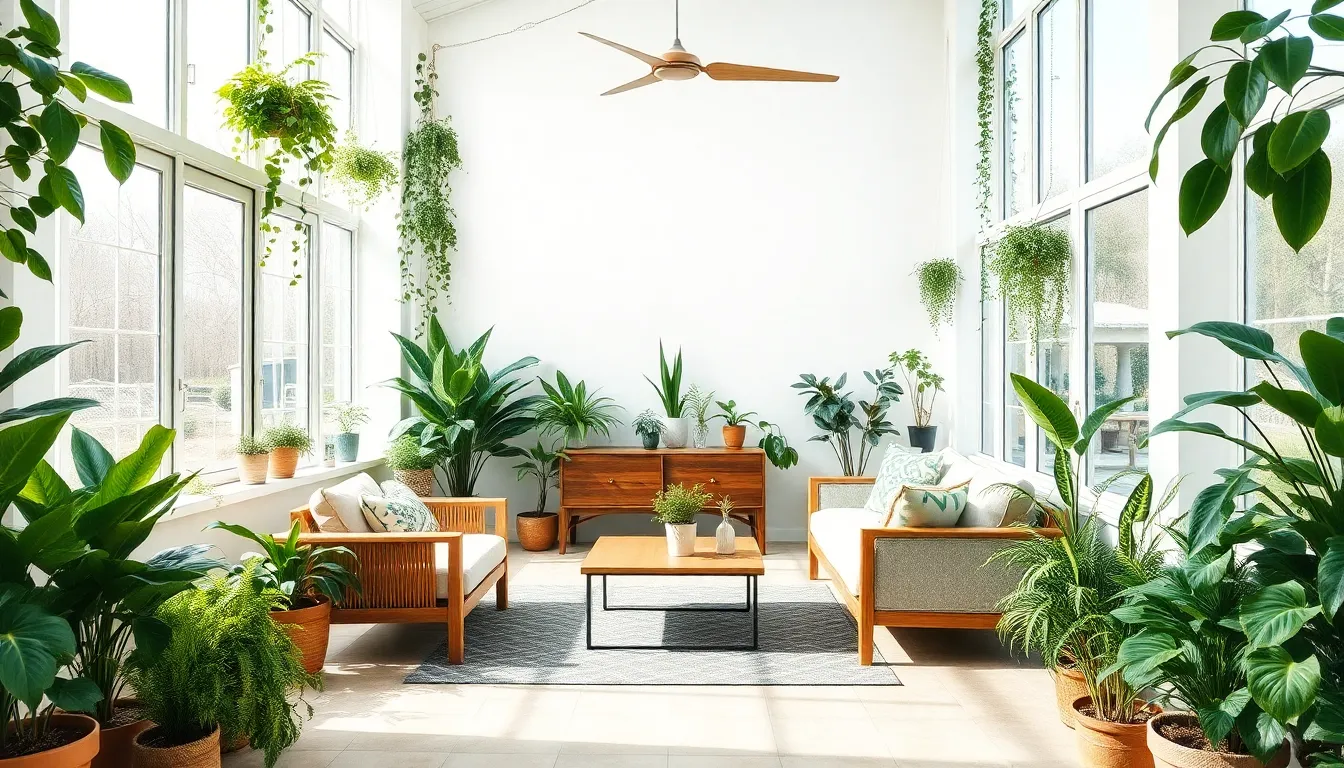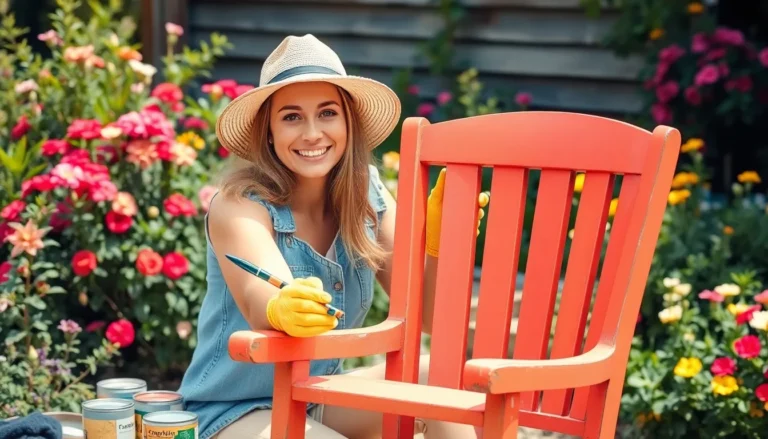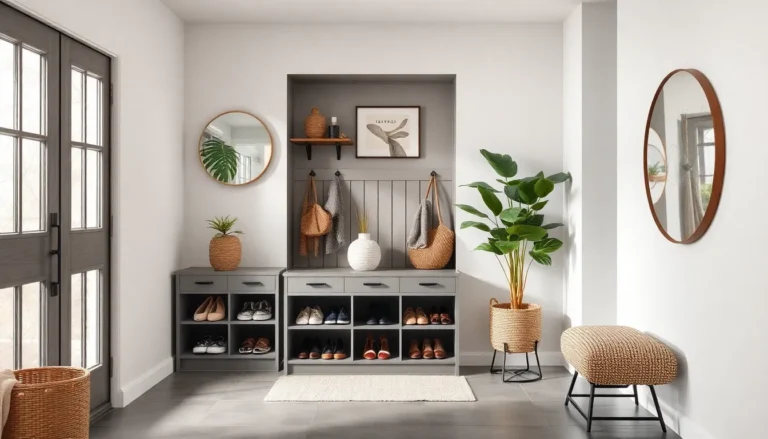Imagine walking into a room that feels like a breath of fresh air—lush plants, vibrant colors, and an undeniable sense of calm. Green interiors aren’t just a trend; they’re a lifestyle choice that transforms spaces into serene sanctuaries. By incorporating natural elements, anyone can create an inviting atmosphere that whispers relaxation while shouting eco-friendliness.
Table of Contents
ToggleWhat Are Green Interiors?
Green interiors refer to environments designed with sustainability and wellness in mind. This approach focuses on using eco-friendly materials, energy-efficient appliances, and natural light to create spaces that are both beautiful and functional. Incorporating elements such as plants enhances air quality and promotes relaxation.
Sustainable practices play a crucial role in green interiors. Utilizing recycled materials, like reclaimed wood or recycled glass, reduces waste and contributes to a healthier planet. Choosing low-VOC paints minimizes harmful emissions and improves indoor air quality, making spaces safer for occupants.
Energy efficiency is a significant aspect of green design. Installing energy-efficient lighting, like LED fixtures, lowers electricity consumption while providing adequate illumination. Using smart technology helps monitor energy usage, leading to better conservation efforts.
Natural light is essential in green interiors. Designing spaces with large windows or skylights maximizes sunlight, reducing reliance on artificial lighting. Strategically positioned windows can also facilitate natural ventilation, enhancing comfort and reducing energy costs.
Ultimately, green interiors embody a lifestyle choice that results in healthier living environments. By emphasizing eco-friendliness and tranquility, these spaces promote mental and physical well-being. Incorporating green practices not only benefits individual occupants but also contributes to a broader commitment to environmental sustainability.
Benefits of Green Interiors

Green interiors offer multiple advantages that improve both personal well-being and environmental health. Incorporating sustainable elements creates a more balanced indoor atmosphere.
Health Advantages
Health benefits of green interiors enhance overall well-being. Natural materials contribute to better indoor air quality, significantly reducing pollutant levels. Plants also play a vital role in this process, providing oxygen and promoting mental clarity. Enhanced natural light exposure improves mood and productivity. Integrating sustainable practices often leads to fewer toxins in paints and finishes, resulting in healthier living spaces. Enhanced comfort through improved acoustics and temperature regulation bolsters relaxation as well.
Environmental Impact
Green interiors significantly lessen ecological footprints. By deploying energy-efficient appliances, occupants use less electricity, reducing greenhouse gas emissions. Choosing recycled materials promotes resource conservation and minimizes landfill waste. Incorporating low-VOC paints and finishes improves indoor environments while lowering the release of harmful chemicals into the atmosphere. Utilizing smart technology aids in monitoring energy consumption, maximizing efficiency. Prioritizing natural lighting reduces reliance on artificial lighting, conserving energy throughout the day. Overall, these practices foster a commitment to eco-friendly living.
Key Elements of Green Interiors
Green interiors focus on creating spaces that support sustainability and well-being through key elements like sustainable materials and energy efficiency.
Sustainable Materials
Sustainable materials form the backbone of green interiors. Recycled content, such as reclaimed wood and recycled metal, enhances aesthetics while reducing waste. Bamboo, known for its rapid growth, serves as an eco-friendly flooring option. Low-VOC paints improve indoor air quality by minimizing harmful emissions. Organic textiles used in furnishings contribute to a healthier environment, free of synthetic chemicals. Moreover, natural fibers like wool and cotton are great choices for upholstery. Using these materials supports an eco-conscious lifestyle and promotes long-lasting beauty in interiors.
Energy Efficiency
Energy efficiency plays a crucial role in green interiors. Energy-efficient appliances, such as Energy Star-certified ovens and refrigerators, significantly lower energy consumption. LED lighting not only reduces electricity use but also lasts longer than traditional bulbs. Incorporating smart technology allows homeowners to monitor and optimize energy consumption, leading to smarter usage decisions. Proper insulation ensures temperature regulation, reducing the demand for heating and cooling. Natural light is maximized through strategically placed windows and skylights, fostering brightness while cutting energy costs. These energy-efficient practices contribute to both financial savings and environmental health.
Designing Green Interiors
Designing green interiors requires a thoughtful approach to aesthetics and functionality. By integrating sustainable elements, spaces become both beautiful and environmentally friendly.
Color Schemes and Aesthetics
Selecting color schemes in green interiors emphasizes natural hues. Earth tones like greens, browns, and beiges promote tranquility and support mental well-being. Incorporating soft whites and creams enhances light reflection, creating a brighter atmosphere. Thoughtful color choices associate with the surroundings, bridging the indoor environment with nature. Designers often recommend non-toxic paints to maintain air quality while achieving the desired aesthetics. Textures also play an important role; combining materials like wood, stone, and organic fabrics leads to a more inviting space. This blend of colors and textures cultivates an overall sense of calm.
Incorporating Nature
Incorporating nature into interiors elevates both visual appeal and health benefits. Integrating plants helps purify air, boosting oxygen levels and creating a more vibrant environment. Potted plants, vertical gardens, and curated flower arrangements add life to any room. Using materials that mimic natural elements, such as stone countertops and wooden furniture, enhances the organic feel. Large windows and skylights not only flood areas with natural light but also create a connection to the outdoors. Nature-inspired patterns on textiles, wallpapers, and artwork can further reinforce this theme. Each of these elements contributes to a harmonious living space that promotes well-being.
Challenges in Implementing Green Interiors
Implementing green interiors presents various challenges that require consideration. High costs often deter homeowners and businesses from adopting sustainable practices. Eco-friendly materials, advanced technology, and energy-efficient appliances generally involve larger upfront investments over traditional options.
Limited access to quality sustainable products also complicates the process. Vendors offering a variety of eco-friendly materials and furnishings may not exist in every region. This availability issue can hinder design choices, particularly in remote areas.
Knowledge gaps among consumers and builders impact the effectiveness of green interior strategies. Many individuals lack awareness of sustainable materials and practices that promote healthier indoor environments. Training programs and educational resources can bridge this gap, yet they are not universally implemented.
Another challenge lies in design limitations. Achieving a balance between aesthetics and sustainability often proves complex. It requires creativity and innovation to ensure that green interiors are not only eco-friendly but also visually appealing.
Regulatory hurdles may also impede the widespread adoption of green practices. Building codes and regulations sometimes do not support eco-friendly modifications, creating barriers for those looking to implement green designs. Staying informed about local regulations and advocating for eco-friendly policies can move the industry forward.
Inns in redesigning existing spaces further complicate the task. Retrofitting older buildings with energy-efficient systems and sustainable materials often incurs additional costs and construction time. Solutions exist but demand careful planning and investment for successful outcomes.
These challenges highlight the need for continued collaboration among designers, manufacturers, and policymakers to create a more supportive environment for green interiors. By addressing these obstacles, a stronger commitment to sustainability can flourish in the design and building industries.
Embracing green interiors is more than just a design choice; it’s a commitment to a healthier lifestyle and a sustainable future. By integrating natural elements and eco-friendly materials, individuals can create spaces that not only look beautiful but also enhance well-being. The benefits extend beyond aesthetics, positively impacting air quality and energy efficiency.
While challenges exist in adopting these practices, the growing awareness and availability of sustainable options are paving the way for more eco-conscious living. As designers and homeowners continue to prioritize green interiors, they contribute to a collective effort to protect the environment and promote healthier living spaces. This shift towards sustainability is essential for fostering a harmonious relationship between people and their surroundings.



